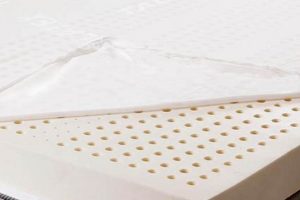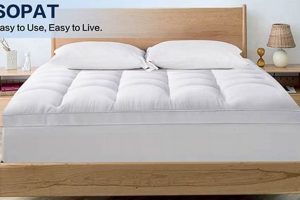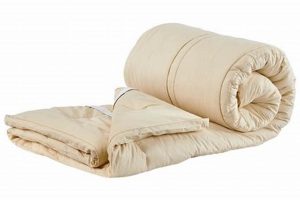A cushioning layer designed to enhance the comfort of a sleep surface used on a movable bed frame. These accessories typically range from one to four inches in thickness and are composed of materials like memory foam, latex, or down alternatives. The purpose is to modify the feel of the underlying sleep surface, adding softness, firmness, or pressure relief, as desired.
Utilizing an appropriate upper layer on a movable platform offers several advantages. It allows users to fine-tune the support and comfort of their bed without replacing the entire mattress. This can be particularly beneficial for individuals with specific needs related to back pain, pressure points, or temperature regulation. Furthermore, these additions can extend the lifespan of the underlying mattress by protecting it from wear and tear. Their use has become increasingly common with the rising popularity of adjustable bed frames that offer customized sleeping positions.
The subsequent sections will delve into the various materials used in construction, factors to consider when selecting one for a movable base, and maintenance guidelines to ensure longevity and consistent performance.
Guidance for Selecting a Compatible Upper Layer
This section provides crucial advice for choosing a surface layer that works effectively on an adjustable bed frame, ensuring both comfort and longevity.
Tip 1: Prioritize Flexibility: Opt for models crafted from adaptable materials such as memory foam or latex. These materials readily conform to the angles of the bed without creating undue stress on the material itself.
Tip 2: Consider Thickness: While a thicker option may seem more comfortable, it can impede the articulation of the bed. A moderate thickness, generally between two and three inches, provides adequate cushioning without compromising functionality.
Tip 3: Evaluate Density: The density of the material impacts its performance on a movable base. Higher density foams tend to be more durable and resistant to compression, maintaining consistent support even when the bed is in an elevated position.
Tip 4: Assess Material Breathability: Look for models with enhanced breathability features, such as open-cell foam or gel infusions. Adequate ventilation prevents heat buildup, a common issue with some foam materials, and contributes to a more comfortable sleeping environment.
Tip 5: Secure the Topper: Utilize straps or a non-slip backing to keep it firmly in place. The movement of an adjustable frame can cause the upper layer to shift, reducing its effectiveness and potentially causing discomfort.
Tip 6: Check Compatibility with Bedding: Ensure existing sheets and bedding are adequately sized to accommodate the added height. Inadequate bedding can restrict movement and diminish the overall comfort.
By carefully considering these factors, users can select a product that optimizes both comfort and functionality on an adjustable bed, enhancing the overall sleep experience.
The final section will summarize the key considerations discussed, solidifying the understanding of how to make an informed purchase.
1. Flexibility
Flexibility is a critical attribute of any cushioning layer intended for use on an adjustable bed. The capacity of the material to conform to varying angles and contours directly impacts its performance, comfort, and lifespan. A lack of flexibility can lead to premature wear, reduced comfort, and potential damage to the adjustable bed frame.
- Conformity to Bed Positions
The primary role of flexibility is to allow the topper to seamlessly adjust as the bed is repositioned. Materials that lack this quality may resist the movement, creating pressure points or gaps between the body and the sleep surface. This can compromise comfort and hinder the benefits of the adjustable bed’s positioning capabilities. For example, a rigid topper may fold awkwardly when the bed is in a seated position, causing discomfort in the lower back.
- Stress Distribution and Material Longevity
Inflexible materials are prone to stress and strain when repeatedly bent or flexed. This concentrated stress can lead to cracking, tearing, or permanent deformation, significantly reducing the product’s lifespan. A flexible topper, conversely, distributes the stress more evenly across its surface, mitigating wear and tear. Consider a topper made of conventional innerspring versus one of latex. Latex has much greater flexibility and would experience far less stress.
- Maintaining Contact and Support
Flexibility ensures continuous contact and consistent support regardless of the bed’s configuration. If a topper lacks this characteristic, it may lift away from the body in certain positions, resulting in uneven pressure distribution and potential discomfort. This is particularly important for individuals seeking pressure relief, as localized pressure points can negate the therapeutic benefits of the adjustable bed. If pressure relief is not maintained as the adjustable bed changes positions, it makes the whole mattress topper useless.
- Compatibility with Bedding
The level of flexibility also indirectly influences compatibility with bedding. A highly inflexible topper might require larger, more elastic sheets to accommodate the changes in shape imposed by the adjustable frame. Conversely, a more pliable topper will readily conform to the existing bedding, minimizing the need for specialized linens. In certain cases it may cause the sheets to wrinkle, rip or become loose.
The degree of flexibility in a cushioning layer determines its suitability for use with an adjustable bed. Selecting a material with appropriate flexibility ensures comfort, extends the topper’s lifespan, and maximizes the benefits of the adjustable bed’s positioning capabilities, thereby making flexibility a critical component in the selection process.
2. Thickness
The thickness of a sleep surface addition designed for use on a movable bed frame significantly impacts both comfort and functionality. The dimension, typically measured in inches, influences the degree of cushioning provided, the responsiveness to adjustments, and the overall longevity of the system. Too much or too little can have deleterious effects on the user’s experience. For example, a very thick topper may provide ample initial comfort but can inhibit the articulation of the bed, creating resistance against the motor and potentially reducing its range of motion. Conversely, a very thin layer may offer minimal cushioning and fail to provide adequate pressure relief, negating the benefits of the adjustable base. A suitable thickness balances these competing factors, ensuring sufficient comfort without compromising the bed’s adjustability.
Consider the practical implications of different t
hickness levels. A thinner option, such as a 2-inch memory foam pad, might be ideal for individuals seeking subtle enhancements to their existing sleep surface and those who prioritize ease of movement. This level provides moderate pressure relief and conforms well to the bed’s contours without significantly restricting articulation. A thicker option, such as a 4-inch latex pad, could be preferable for those desiring more pronounced cushioning and enhanced support. However, this greater thickness may require more powerful motors in the adjustable bed frame and potentially reduce the range of available positions. The selection process should, therefore, involve a careful evaluation of individual preferences, the capabilities of the bed frame, and the intended purpose of the sleep surface accessory.
In summary, the thickness of a cushioning layer on an adjustable bed is a critical determinant of its effectiveness. It is not merely a matter of personal preference but a factor that influences the entire system’s performance. Finding the optimal thickness involves considering comfort needs, the specifications of the adjustable base, and the potential trade-offs between cushioning and functionality. Understanding this relationship ensures a more informed purchasing decision and contributes to a better overall sleep experience.
3. Material Density
Material density, measured as mass per unit volume, is a critical factor influencing the performance and suitability of a cushioning layer atop a movable bed. It directly impacts support, durability, and the ability of the topper to conform effectively to the adjustable frame’s various positions. Lower-density materials, while often more cost-effective, may compress excessively under body weight, leading to inadequate support and a reduced lifespan. Higher-density materials, conversely, provide greater resistance to compression, maintaining consistent support even under prolonged use and at varying angles of articulation. For example, a high-density memory foam topper will retain its shape and support characteristics better than a low-density counterpart when the adjustable bed is in a raised position, preventing pressure points and ensuring consistent comfort.
The density of the material used also affects its responsiveness and heat retention properties. Denser materials tend to retain more heat, which can be a disadvantage for individuals prone to overheating during sleep. However, advancements in material technology, such as open-cell foam structures and gel infusions, mitigate this issue by promoting airflow and dissipating heat more efficiently. The choice of density should therefore be informed by individual preferences, climate, and the presence of heat-regulating technologies. Furthermore, material density plays a vital role in the topper’s ability to withstand the repeated flexing and adjustments of the bed frame. A higher-density topper is less likely to develop cracks or deformations over time, ensuring long-term performance and value. These factors are especially important in situations where adjustable beds are used for medical purposes, where consistent support and durability are paramount.
In conclusion, material density is a fundamental consideration when selecting a cushioning layer for an adjustable bed. It influences support, durability, heat retention, and overall comfort. The optimal density depends on individual needs and preferences, but a careful assessment of this characteristic is essential for maximizing the benefits of both the topper and the adjustable bed frame. Balancing density with other features like breathability and material composition is key to achieving a comfortable and supportive sleep environment.
4. Breathability
Breathability, defined as the capacity of a material to permit the passage of air and moisture, is a crucial factor in determining the comfort and effectiveness of a sleep surface addition used on an adjustable bed. Its relevance stems from the potential for increased heat retention and moisture buildup associated with certain materials and designs, particularly when used in conjunction with the conforming nature of adjustable bed frames.
- Temperature Regulation
The primary role of breathability is to facilitate temperature regulation. Materials that lack adequate airflow can trap body heat, leading to discomfort and disrupted sleep. This is particularly problematic in memory foam, a common material for upper layers, which tends to retain heat. Enhanced breathability, achieved through open-cell structures or infused cooling gels, allows for the dissipation of heat, maintaining a more consistent and comfortable sleep temperature. For instance, a topper with poor ventilation used in a warm climate could lead to overheating and night sweats, negating the benefits of the adjustable bed. A highly breathable topper, on the other hand, can promote airflow and wick away moisture, creating a cooler and more restful sleep environment.
- Moisture Management
Breathability is also essential for managing moisture levels within the sleep environment. During sleep, the body releases moisture, which can accumulate within the topper material. Poorly ventilated surfaces can trap this moisture, creating a breeding ground for bacteria and allergens. A breathable topper wicks away moisture, preventing the buildup of humidity and promoting a healthier sleep surface. This is especially important for individuals with allergies or sensitivities to mold and mildew. Breathable materials, such as latex, help combat the build-up of humidity.
- Material Durability
The breathability of a topper can indirectly influence its durability. Excessive moisture buildup can degrade certain materials over time, leading to premature wear and tear. A breathable topper, by preventing moisture accumulation, helps to maintain the integrity of the materials and extend its lifespan. For example, foam that is constantly damp will degrade faster, diminishing the long-term comfort and support provided by the topper. By inhibiting mold and mildew growth, they provide a healthier sleep surface.
- Conformity and Airflow
Adjustable beds often involve curved or elevated positions, which can compress certain areas of a topper and restrict airflow. A breathable topper maintains airflow even under compression, ensuring consistent temperature regulation across the entire surface. This is particularly relevant for individuals who use their adjustable beds in various positions throughout the night. A poorly ventilated topper would cause a build-up of humidity in compressed areas.
In summary, breathability is not merely a comfort feature but an integral aspect of the overall performance and longevity of a surface layer on an adjustable bed. By promoting temperature regulation, managing moisture levels, and maintaining material integrity, breathability contributes to a more comfortable, hygienic, and durable sleep environment.
5. Secure Fit
The stability of a cushioning layer atop a movable bed is paramount to ensuring consistent comfort and support. A secure fit prevents slippage, maintains proper alignment, and optimizes the functionality of both the upper
layer and the adjustable base.
- Preventing Displacement During Articulation
Adjustable beds change position frequently, creating shear forces that can easily displace an unsecured topper. This displacement results in uneven support, pressure points, and a general degradation of the sleep experience. A secure fit is achieved through methods such as elastic straps, fitted sheets with deep pockets, or non-slip backings that grip the mattress surface. These mechanisms counteract the forces generated by the bed’s movement, maintaining the topper’s intended position. Without securing the topper, it becomes impossible to maintain consistent levels of comfort and stability for the user.
- Enhancing User Safety and Accessibility
A shifting upper layer poses a safety hazard, particularly for individuals with mobility issues. A displaced topper can create tripping hazards or make it difficult to get in and out of bed safely. A secure fit mitigates these risks by keeping the surface stable and predictable. This aspect is particularly crucial in healthcare settings where adjustable beds are frequently used to aid patients with limited mobility. By ensuring the patient has a stable surface it allows them to get in and out of the bed with less issues.
- Preserving the Topper’s Integrity and Longevity
Constant shifting and bunching can cause premature wear and tear on the topper material. A secure fit minimizes these stresses, prolonging the lifespan of the topper and protecting the investment. Friction between the topper and the mattress surface can lead to abrasion, pilling, and even tears over time. By securing the topper in place, these abrasive forces are reduced, preserving its structural integrity and appearance.
- Optimizing Therapeutic Benefits
Adjustable beds are often used to alleviate specific medical conditions, such as back pain or sleep apnea, by promoting proper spinal alignment and improving circulation. An insecure topper can compromise these therapeutic benefits by allowing the body to sink into unsupported areas. A secure fit ensures that the topper maintains its shape and provides consistent support across the entire sleep surface, optimizing the therapeutic effects of the adjustable bed. When you allow shifting and bunching of the topper, you are not maintaining a secure and solid surface for the user.
The interplay between a cushioning layer and an adjustable bed is critically dependent on a secure fit. This aspect not only enhances comfort and safety but also preserves the longevity and therapeutic benefits of both components. Employing appropriate securing mechanisms is essential for maximizing the user’s sleep experience.
Frequently Asked Questions
The following section addresses common inquiries regarding selecting and using a supplementary sleep surface layer in conjunction with a movable bed frame.
Question 1: Will any sleep surface addition be suitable for use on an adjustable bed?
No. Rigid or excessively thick models may impede the bed’s articulation, reducing its range of motion and potentially damaging the motor. Flexible materials with moderate thickness are recommended.
Question 2: How does material density impact the performance?
Density influences support, durability, and heat retention. Higher-density materials provide greater resistance to compression and maintain consistent support, but may retain more heat. The ideal density balances support needs with thermal comfort preferences.
Question 3: Why is breathability important?
Breathability promotes airflow and dissipates heat, preventing overheating and moisture buildup. Inadequate ventilation can lead to discomfort, bacterial growth, and premature material degradation.
Question 4: How can movement or slippage be prevented?
Secure fit is achieved through elastic straps, fitted sheets with deep pockets, or non-slip backings. These mechanisms counteract the forces generated by the bed’s movement, maintaining the intended position.
Question 5: Does thickness impact sheet fit?
Yes. Adding a thick upper layer may require larger sheets to accommodate the increased height. Inadequate bedding can restrict movement and diminish overall comfort.
Question 6: How does topper selection impact longevity?
Selecting appropriate flexibility and density, ensuring breathability, and maintaining a secure fit contribute to longevity. These factors minimize stress, prevent moisture buildup, and prolong the lifespan of the topper.
Careful consideration of material properties, dimensions, and securing mechanisms is crucial for optimizing comfort, functionality, and longevity. These considerations ensure a satisfying long-term user experience.
The following section will present a summary of key points for choosing the best options for your needs.
Conclusion
The selection of a mattress topper for adjustable bed systems necessitates a nuanced understanding of material properties, dimensional constraints, and securing mechanisms. Rigidity compromises adjustability, while inadequate density sacrifices support. Breathability dictates thermal comfort, and a secure fit ensures consistent performance. The interdependency of these factors underscores the importance of informed decision-making.
Ultimately, the appropriate mattress topper for adjustable bed optimizes comfort, enhances therapeutic benefits, and extends the lifespan of both components. Prioritizing these considerations guarantees a more restful and restorative sleep experience, thereby contributing to enhanced well-being.




![Best Half Queen Mattress Topper: [Benefits] & Sleep Better! Organic & Natural Mattress Buyer’s Guide: Non-Toxic Sleep Solutions Best Half Queen Mattress Topper: [Benefits] & Sleep Better! | Organic & Natural Mattress Buyer’s Guide: Non-Toxic Sleep Solutions](https://mattressworldpa.com/wp-content/uploads/2025/07/th-5936-300x200.jpg)


